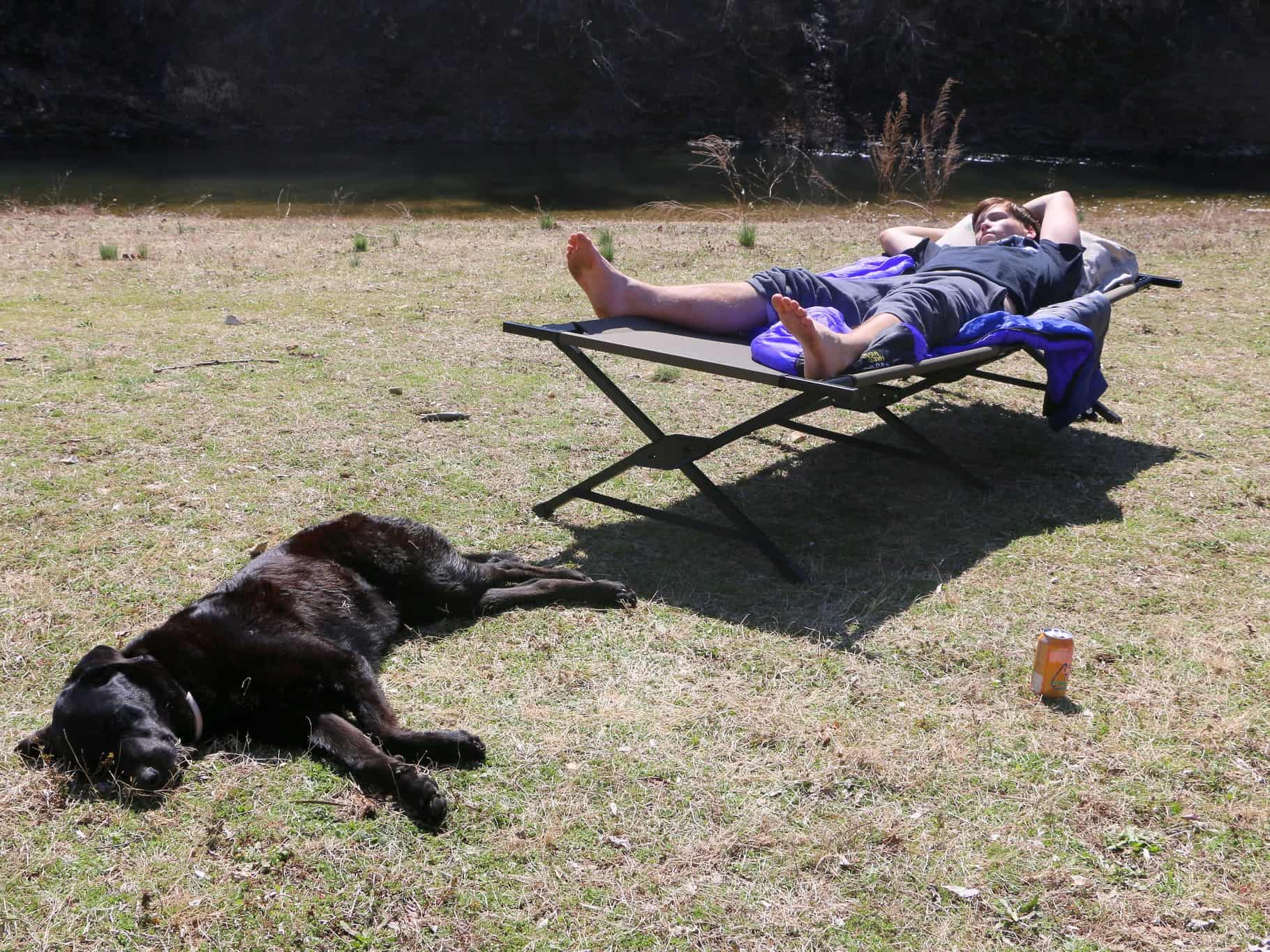Last updated on January 24th, 2023 at 11:23 am
Avid campers continually search for better ways to obtain a good night’s rest. Deciding between a camping cot vs. hammock presents an array of options. To choose, simply decide which is best for your camping style.
Although they require more work, most campers concur that hammocks are more comfortable than cots unless you have a bad back. In the end, they’re worth it.
What is a Camping Cot
Camping cots come in a variety of styles, but all essentially fold into elevated beds, keeping you off the ground. They usually come with wood, aluminum, or steel frames and have nylon, polyester, or canvas material stretched across their frames.
A good camping cot should be fairly lightweight, easy to erect and tear down, and easy to clean. Most campers prefer aluminum frames with nylon or polyester surface.
Cots come in a variety of sizes and styles. They provide a great deal of comfort, particularly if you struggle with back problems. Some come with extra padding, and some provide a tent canopy. Some can sleep two, and some can recline.
All of them typically fold into compactable units and are easy to transport. However, they are typically too heavy and bulky for backpacking.
Cot Pros:
- Easy to assemble
- Sturdy and durable
- Better for bad backs
Cot Cons:
- More expensive
- Heavy and bulky
What is a Camping Hammock
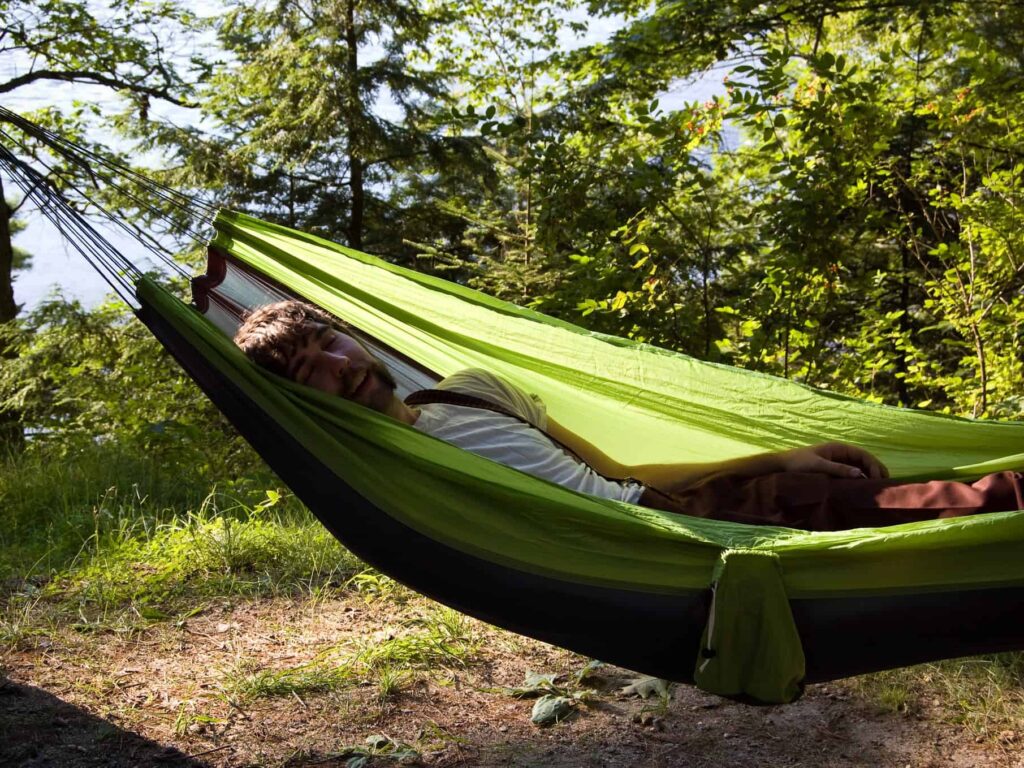
Camping hammocks are long pieces of fabric usually made from nylon or canvas. Each end features a rope attached to it. The ropes are then tied around two trees so that the hammock is suspended in the air.
Hammocks are gaining popularity as sleeping alternatives while camping. They can pack down to the size of a softball, so they take up very little space. Additionally, they’re super affordable for those on a budget.
They come in several sizes, and most campers attest the larger ones usually feel more comfortable.
Make sure you find one that fits your size. A hammock that’s too small will definitely ruin your sleep.
Some hammocks even come with their own mosquito netting and rainfly.
Hammocks can be adjusted using a ridgeline that assists in controlling the amount of sag. Simply find your comfort level and adjust accordingly.
Additionally, both cots and hammocks will be made of nylon which is easily damaged by sparks out of a campfire. So, to keep your party going through the night, we suggest keeping both options far from the fire. And, if you can, invest in one of our favorite portable, wood-free fire pits from our Best Portable Gas Fire Pit for Camping post.
Hammock Pros:
- Compact and lightweight
- Budget-friendly
- More comfortable
Hammock Cons:
- Requires more work
- Exposes you to the elements
Both Get You Off the Ground
Both cot and hammock elevate you off the ground, offering you a comfortable night’s sleep.
Cots generally lay level allowing you to stretch out flat. They provide better back support for those who prefer a firm sleeping foundation.
On the other hand, tied between two trees, hammocks have more of a gravity curve. This allows you to rest in a slightly reclined position, and you can adjust it to your liking.
While both get you off ground, neither do well at preserving body heat. In colder weather, both require sleeping pads for better insulation.
Because of being elevated off the ground, the cold air is allowed to flow underneath your body. This presents a huge disadvantage in the colder months, but can certainly keep you cooler in the summer.
Now, while you won’t be on the dirty ground, you may still want the luxury of a shower. If this sounds like you, check out our Best Portable Shower for Camping post.
Camping Cots are Much Heavier
One of the biggest inconveniences to camping cots is their weight. This is especially true if you’re a backpacker. When it comes to a heavy camping cot vs. hammock weight, hammocks are a serious winner. Plus, you’ll also have to have a tent with a cot, adding further weight.
Hammocks are the perfect alternative for hiking and backpacking as long as you have trees available. They take up very little space, and they’re extremely lightweight.
Conversely, cots are much bulkier and heavier.
While they do collapse, you simply can’t make them as small as a bundled hammock. Cots weigh anywhere from ten to thirty pounds, so they don’t work well for those who enjoy thru-hikes.
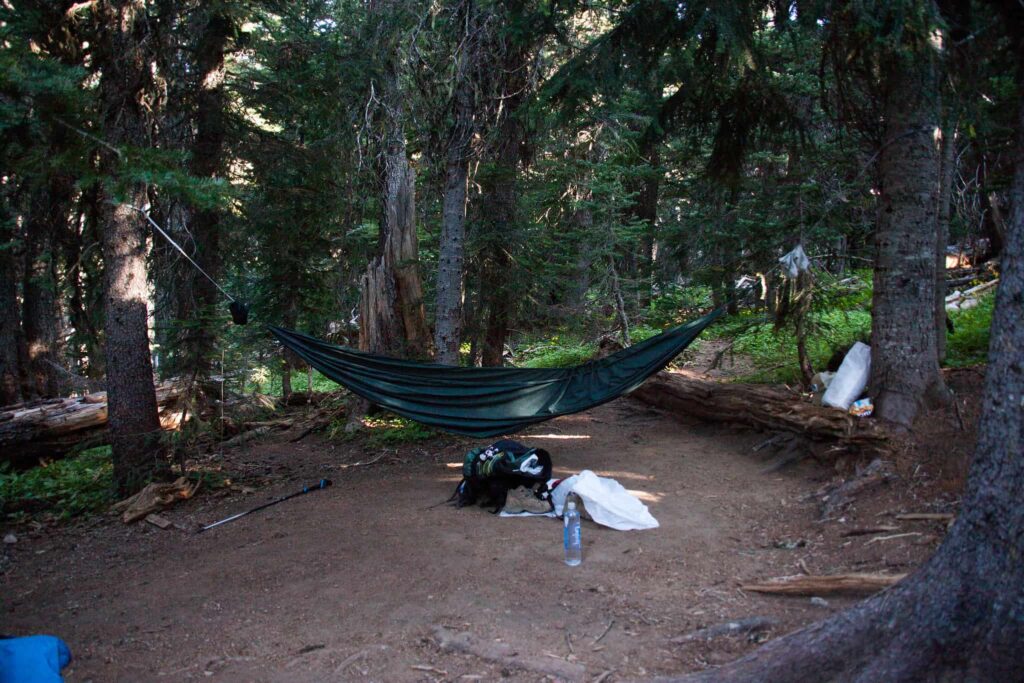
Most Cots Still Require a Tent
The majority of cots require a tent, although a few do convert into tents. Most cots, however, have no protection from insects, wildlife, or elements without utilizing a tent for protection.
Some manufacturers, however, produce hammocks that come equipped with mosquito netting and rainfly for added protection. You get the best of both worlds: protection and comfort.
Cots Save Space
Cots do a great job at getting you off the ground and providing you with a comfortable rest. They also provide a great way to organize your gear. The space underneath makes it easy to store your gear helping keep your tent neat and organized.
While you could also place your gear under a hammock, hammocks offer no protection from the elements.
You could place a tarp underneath your hammock to act as a barrier between your gear and the ground. However, your belongings would still be left exposed to the weather.
Camping Cots are Better for Back Pain
Cots do a much better job at supporting your back. They are the best option if you suffer from chronic back pain. Not only do they offer firm support, but their elevation also makes them easier to get up and down.
On the contrary, hammocks are very flimsy and pliable. At times, it’s difficult to get decent leverage for getting in and out of a hammock without tipping over. Because they are suspended in air, they offer zero resistance.
Unfortunately, this can result in straining an already bad back.
Camping Cots Offer More Privacy
Obviously, you get a great deal more privacy in a tent since it provides a closed structure. Having a cot inside a tent alleviates any worry about disrobing at bedtime.
While mosquito netting and rainfly give you some privacy in a hammock, it just doesn’t compare to that of a tent. Not to mention, you have very little room in comparison. You’d have a hard time changing your clothes in a hammock.
If you value privacy, then cots are the better option.
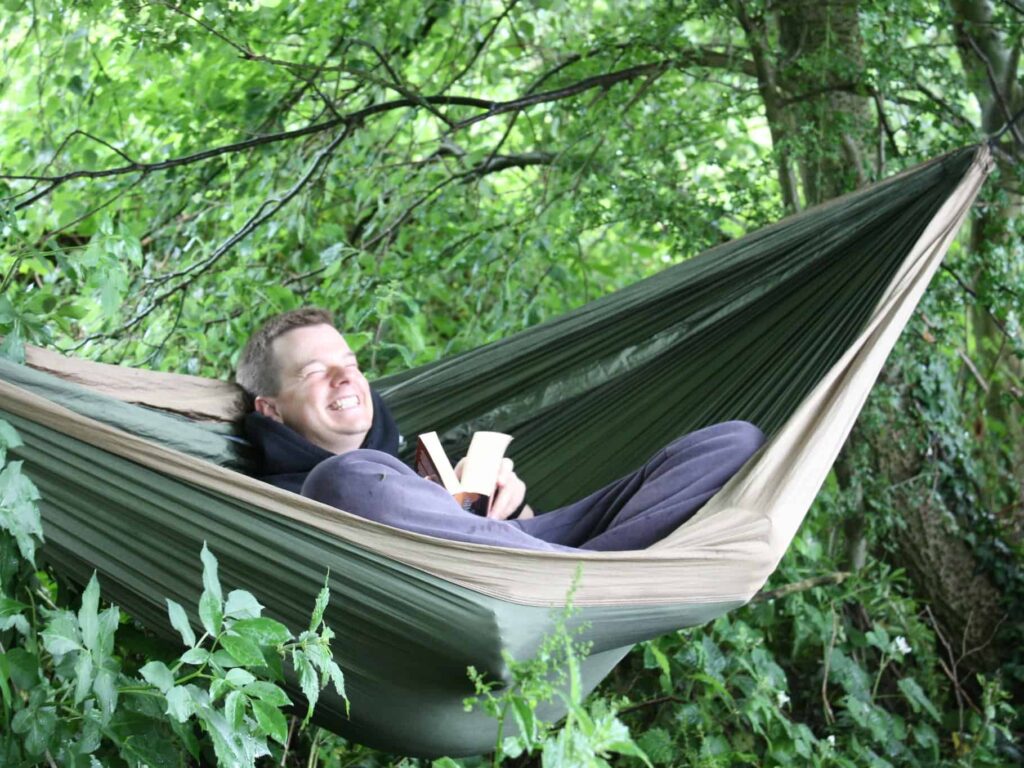
Hammocks are Less Expensive on Average
If you live on a budget, hammocks are definitely less expensive in the camping cot vs. hammock debate. You can purchase a good-quality hammock for a fraction of the cost when compared to a cot. Quality hammocks can be purchased for between $20-80, whereas a solid tent runs anywhere between $80-200.
So for around $80, you can get a high-end, quality hammock, or a low-end, mediocre tent.
Hammocks are More Comfortable
Many campers prefer the comfortableness of hammocks over cots. I personally enjoy the feeling of floating in conjunction with the soft sway of the swing. It’s also a great relief for sleep apnea since it places you in that slightly inclined position.
We all know comfort is quite subjective. However, campers who complain that hammocks aren’t very comfortable usually don’t have them set up quite right.
Many adventurers new to hammocks tend to hang them too tight not allowing enough sag. This can ruin your sleep. Learning how to install a ridgeline can help alleviate this problem.
You might need to tweak your hammock a time or two before you find your perfect zen. However, once you find it, you’ll have the most perfect rest ever.
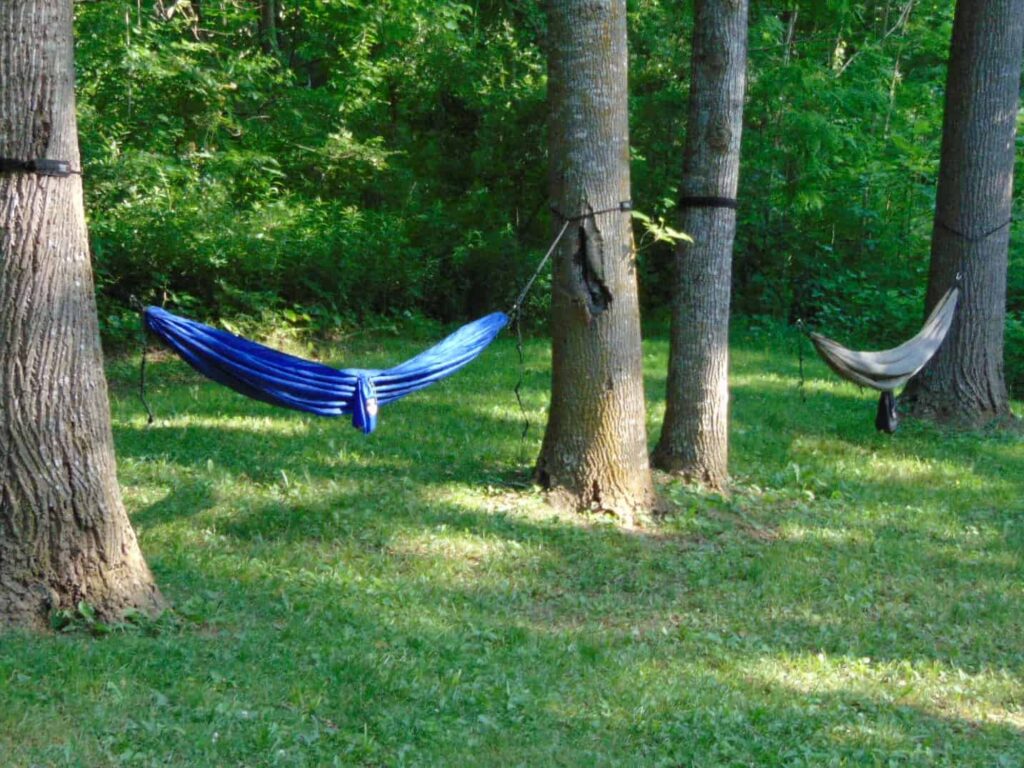
Hammocks are Better for Side Sleepers
For campers that prefer to lay on their sides, a hammock sometimes works better. Because of a cot’s firmness, they don’t have much give in their fabric. This often places increased pressure on the shoulder and hip areas and can result in soreness and bruising.
Furthermore, it could contribute to a restless night of tossing and turning. However, as mentioned earlier, those that have chronic back issues typically do better on cots.
In truth, a properly strung hammock can conform to your body making you snug as a bug in a rug. With an adjustable ridgeline, you can set the sag of the hammock to your comfort level.
To comfortably lay on your side in a hammock, ensure that it is long enough and wide enough. Otherwise, you may run into complications. If you’re planning on using a sleeping pad, don’t forget to add a few extra inches to compensate. And, check out our Best Sleeping Pad for Side Sleepers post for more help.
If you’re a restless sleeper and constantly change positions throughout the night, you may find hammocks a little more challenging. With a little practice, however, you’ll get used to it in no time.
Hammocks Require More Effort
When comparing a camping cot vs. hammock, the cot is definitely easier to set up. All you have to do is unfold it and attach any necessary bracing. However, a tent usually accompanies a cot, which also has to be set up.
On the other hand, hammocks require two trees. Finding two perfectly spaced trees can be a challenge in and of itself.
Plus, if you’re short like me, it’s sometimes strenuous getting the hammock ropes high enough. It’s even more difficult to prevent your rope from slipping down while trying to tie your knots.
There’s also the labor involved with setting up your ridgeline. Although not all campers choose to use a ridgeline, I highly recommend it. An adjustable ridgeline works best because it allows you to set the sag level of your hammock.

Rise and Shine Refreshed
Hammocks are fun and relaxing, and they provide a unique sleeping experience unlike any other. If you’re still apprehensive about trying a hammock, why not take both on your next camping trip.
You can experiment with your hammock during the day. They’re great for lounging, short siestas, and stargazing. If you decide you don’t like the hammock, then you always have your cot as a backup. When it comes to deciding between camping cot vs. hammock, we too are split. As a side sleeper and as someone that packs light, hammocks are a clear winner. But when it comes to set up and getting into hammocks, cots are a great choice.
However, hammocks are always fun to have around a campsite even if you don’t sleep in them. So, depending on your camping style and destination, you will have to make your personal preference.
About the Author
Sarah Sampsell
Title Image Credit, Camping Cot vs. Hammock: OakleyOriginals | (source) | Attribution 2.0 Generic (CC BY 2.0) — reduced file size and image
Camping Cot vs. Hammock, Image Credit 1: Brian Boucheron | (source) | Attribution 2.0 Generic (CC BY 2.0) — reduced file size and image
Image Credit 2, Camping Cot vs. Hammock: pixelgerm| (source) | Attribution-NoDerivs 2.0 Generic (CC BY-ND 2.0) — reduced file size and image
Camping Cot vs. Hammock, Image Credit 3: Dark Dwarf| (source) | Attribution-NoDerivs 2.0 Generic (CC BY-ND 2.0) — reduced file size and image
Camping Cot vs. Hammock, Image Credit 4: Virginia State Parks| (source) | Attribution 2.0 Generic (CC BY 2.0) — reduced file size and image
Image Credit 5, Camping Cot vs. Hammock: Rosalee Yagihara| (source) | Attribution 2.0 Generic (CC BY 2.0) — reduced file size and image

